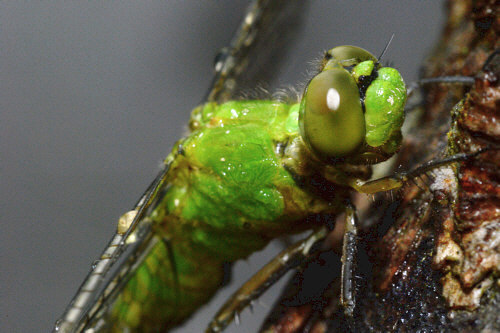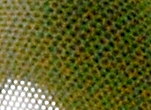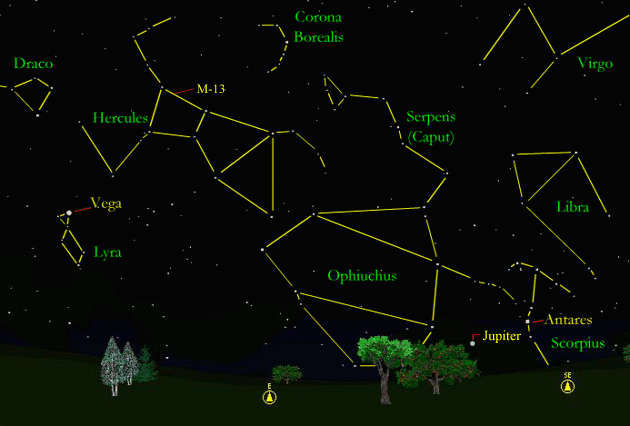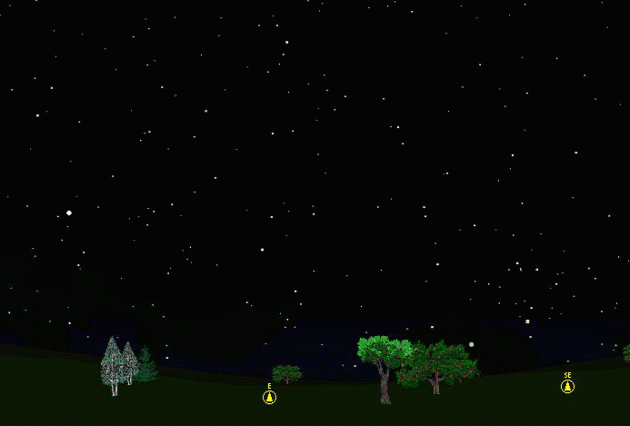The purpose of this feature is to give scout leaders, educators and naturalists an idea of some of the natural events coming up each month. We will try to cover a variety of natural events ranging from sky events to calling periods of amphibians, bird and mammal watching tips, prominent wildflowers and anything else that comes to mind. We will also note prominent constellations appearing over the eastern horizon at mid-evening each month for our area for those who would like to learn the constellations. If you have suggestions for other types of natural information you would like to see added to this calendar, let us know! Note: You can click on the hyperlinks to learn more about some of the featured items. To return to the Calendar, hit the "back" button on your browser, NOT the "back" button on the web page. All charts are available in a "printer friendly" mode, with black stars on a white background. Left clicking on each chart will take you to a printable black and white image.
Notes and Images From April 2008
Globular clusters are spherical clusters of stars that inhabit the halo of galaxies and orbit the galactic core. Of the globular clusters visible from our latitude, perhaps the grandest is Messier 13. M13 is about 25,000 light-years distant, and is composed of several hundred thousand stars. The diameter is said to be around 145 light-years. Discovered by Edmund Halley in 1714, M13 is bright enough that it can just be made out with the naked eye on clear summer nights when it is high overhead. As Halley himself noted, you will need a night when, "the sky is serene and the moon absent." It is quite easy to see in binoculars, and appears as a small fuzzy glow (see the star chart below for its location in the sky.) With small telescopes you can resolve some of the stars around the edges of the cluster. Large telescopes reveal myriads of faint stars across the core. Robert Burnham viewed Messier 5, a globular cluster near M13, through the 40" reflector of the U.S. Naval Observatory station at Flagstaff, Arizona. He wrote;
I sometimes enjoy tracking globular clusters down, usually with a star chart and a pair of binoculars, on spring and summer evenings. There's usually a frog chorus drifting up from the pond, and occasionally an Eastern Screech-Owl trills from our cedars.
Flight Deck: We watched as this newly transformed female Common Green Darner pumped up its wings in preparation for its first flight. Dragonfly eggs hatch in 5 to 10 days, and the brown or green aquatic larvae are sometimes called nymphs or naiads. They are typically the top carnivore in freshwater habitats without fish. As the larvae grow they molt their skin 8-17 times, and the time spent as a larva can be as long as 8 years in some species. At the end of this period, the larvae climb out of the water and hook their claws into a support. They swallow air and the increased pressure in their bodies splits the larval skin. The wings and other parts of its body slowly gain strength and stiffness, and the transformed dragonfly is ready to take flight.
The galaxies NGC 5360, NGC 5363 and NGC 5364 are in a remote part of the Virgo cluster of galaxies called the Virgo III cloud. Around 70 million light-years distant, they form a pretty grouping. NGC 5364, at upper left, is a classic spiral galaxy, while NGC 5363, at right, is an elliptical galaxy. Elliptical galaxies are generally thought to be older galaxies and may have been formed in the merger of several spiral galaxies. NGC 5360 is the edge-on galaxy at bottom left. We imaged this grouping on April 7th and April 8th.
Sky Events for May 2008: Evening Sky: Mercury has its best evening apparition of the year in May, reaching greatest elongation from the sun on May 13th. This is a great chance to see Mercury, and all you need is a clear western sky after sunset and a relatively flat northwestern horizon. A pair of binoculars will improve your view. Look for the fleet-footed planet from the first week in May till around May 18th about 30 to 45 minutes after sunset. The waxing crescent moon will be above Mercury on May 6th and can help guide you to the planet. After the third week in May it becomes difficult to see. Binoculars will also be handy to observe Mars pass in front of the Beehive Cluster in Cancer. Look for the red planet to slowly cross this pretty star field on the evenings of May 22nd, 23rd and 24th. It starts the month in Gemini, and will closely resemble the star Pollux in brightness and color. Saturn is high overhead at dusk near the bright star Regulus in Leo. Any small telescope will give a great view of the rings.
Morning Sky: Jupiter is about 30 degrees above the southeastern horizon at dawn at the beginning of the month and rises before midnight by the end of May. All times noted in the Sky Events are for Franklin, Tennessee and are Central Daylight Time. These times should be pretty close anywhere in the mid-state area.
Constellations: The views below show the sky looking east at 9:50pm CDT on May 15th. The first view shows the sky with the constellation outlined and names depicted. Star and planet names are in yellow. Constellation names are in green. The second view shows the same scene without labels. New constellations this month in the eastern sky are Lyra, the Lyre, with it's bright star Vega, and Ophiuchus, the Serpent Bearer, Libra, the Scales, and the head and upper body of Scorpius, the Scorpion. Look in the southeast for Scorpius and its bright red star Antares. You may want to check out the globular cluster M13 in Hercules. A cluster of stars about 25,000 light years away, M13 can be made out with the naked eye in a dark country sky when the constellation is high in the sky. Binoculars help pick it out.
On Learning the Constellations: We advise learning a few constellations each month, and then following them through the seasons. Once you associate a particular constellation coming over the eastern horizon at a certain time of year, you may start thinking about it like an old friend, looking forward to its arrival each season. The stars in the evening scene above, for instance, will always be in the same place relative to the horizon at the same time and date each May. Of course, the planets do move slowly through the constellations, but with practice you will learn to identify them from their appearance. In particular, learn the brightest stars (Like Antares and Vega in the above scene looking east), for they will guide you to the fainter stars. Once you can locate the more prominent constellations, you can "branch out" to other constellations around them. It may take you a little while to get a sense of scale, to translate what you see on the computer screen or what you see on the page of a book to what you see in the sky. Look for patterns, like the stars that make up the constellation Hercules. The earth's rotation causes the constellations to appear to move across the sky just as the sun and the moon appear to do. If you go outside earlier than the time shown on the charts, the constellations will be lower to the eastern horizon. If you observe later, they will have climbed higher. As each season progresses, the earth's motion around the sun causes the constellations to appear a little farther towards the west each night for any given time of night. If you want to see where the constellations in the above figures will be on June 15th at 9:00pm CDT, you can stay up till 11:00pm CDT on May 15th and get a preview. The westward motion of the constellations is equivalent to two hours per month. Sky Publishing has just come out with a beautiful and compact star atlas, Sky & Telescope's Pocket Star Atlas. It is destined to become a classic, and is a joy to use at the telescope. A good book to learn the constellations is H. A. Rey's
classic,
The Stars, A New Way to See Them. Rey's depictions of the
constellations and witty commentary are terrific. A good general reference book on astronomy is the Peterson
Field Guide,
A Field Guide to the Stars and Planets, by Pasachoff.
The book retails for around $14.00. Starry Night has several software programs for learning the night sky. Visit the Starry Night web site at www.starrynight.com for details.
Amphibians:
By the end of May all of Tennessee's frogs and toads are either calling or have already reached their peak calling period and are being heard less. The treefrogs are the last of our frogs and toads to start calling. Cope's Gray Treefrog and Gray Treefrogs start giving isolated calls as early as March, and by the end of this month listen also for Bird-Voiced Treefrogs, Green Treefrogs and Barking Treefrogs. In May we also hear Fowler's Toads calling frequently, so listen for their "crying baby" call. Northern Cricket Frogs are hitting their stride as well. Listen for a sound like two stones being tapped together. We have heard eight or more species of frogs calling on some May evenings, so it's a great time to listen. Southeastern Chorus Frogs and Northern Spring Peepers continue to call. Listen for their calls to increase in pitch and quicken with the rising temperatures.
Birds: Try to get out with a pair of binoculars in the early morning in the first two weeks of May to take full advantage of the spring migration. The later nesting owls like Eastern Screech Owls are nesting right now. In late May and early June, the young screech owls can sometimes be heard giving their raspy "begging" calls. Easier to hear is a sound that the adult owls make around the young owls, a downward slurred whistle about a half second in duration. This call sounds more like a puppy whimpering than an owl, but you can sometimes follow the sound and come upon a whole group of young screech owls on a tree limb. Recommended: Bird Finding in Tennessee, Michael Lee Bierly. A classic guide to finding birds in Tennessee. The Sibley Guide to Birds, David Allen Sibley The Sibley Guide to Birds of Eastern North America, David Allen Sibley An inexpensive guide for beginners is the Golden Guide for Birds.
Archives (Remember to use the back button on your browser, NOT the back button on the web page!)
Natural Calendar February 2008 Natural Calendar December 2007 Natural Calendar November 2007 Natural Calendar September 2007 Natural Calendar February 2007 Natural Calendar December 2006 Natural Calendar November 2006 Natural Calendar September 2006 Natural Calendar February 2006
Natural Calendar
December 2005
Natural Calendar
November 2005
Natural Calendar
September 2005
Natural Calendar
February 2005
Natural Calendar
December 2004
Natural Calendar
November 2004
Natural Calendar
September 2004
Natural Calendar
February 2004
Natural Calendar
December 2003
Natural Calendar
November 2003
Natural Calendar
September 2003 Natural Calendar February 2003 Natural Calendar December 2002 Natural Calendar November 2002 Nature Notes Archives: Nature Notes was a page we published in 2001 and 2002 containing our observations about everything from the northern lights display of November 2001 to frog and salamander egg masses. 1 Dragonflies Through Binoculars, Sidney w. Dunkle, Oxford University Press Night scenes prepared with Starry Night Pro software All images and recordings © 2008 Leaps
|






